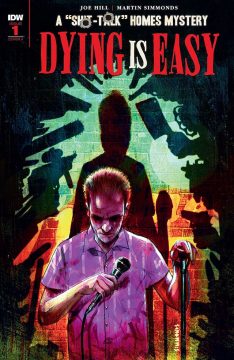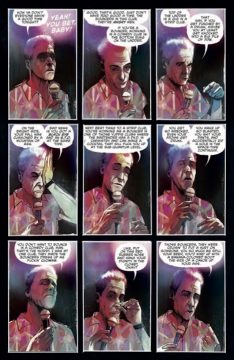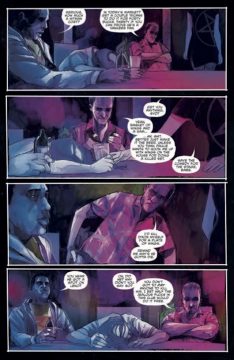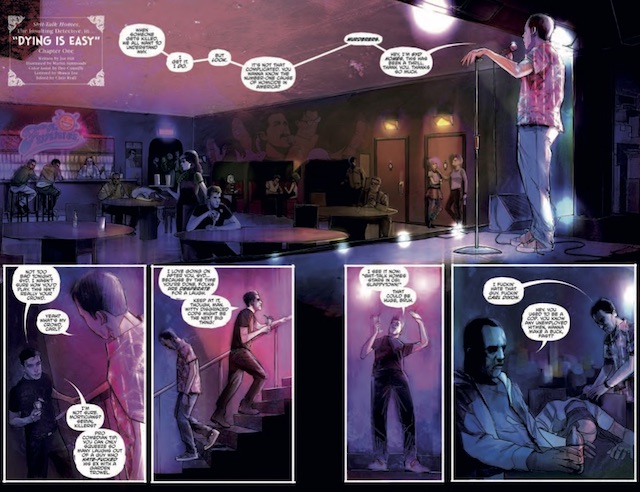“I love drawing talking scenes, it’s often more challenging than faster paced action” Martin Simmonds on the darker side of stand up comedy in Dying Is Easy
It’s been a great year for original new series at IDW this year with the like of Moutainhead and Road Of Bones making our Best of the Year list. Joining that list is the superstar team of Joe (Lock and Key) Hill and Martin (Punks not Dead) Simmonds to being us a new series set in the seedy world of stand up comedy. We catch up with Martin to find out more about comedy inspirations and the secret of a great talking scene.
 Dying Is Easy sees you team up with Locke and Key creator Joe Hill, how did this come about? Did Joe come to you with the idea or was it more of a joint effort?
Dying Is Easy sees you team up with Locke and Key creator Joe Hill, how did this come about? Did Joe come to you with the idea or was it more of a joint effort?
Martin Simmonds: Initially, Chris Ryall got in touch with me to ask if I’d be interested in working with him and Joe on a new creator-owned series. At this stage, Joe had written the first issue and was in the process of planning out the other issues. Seeing as it’s a fair-play mystery, Joe was careful to make sure all the clues were placed correctly throughout the entire series before I started work on the art, so by the time I started work on issue 1, the series was all planned out.
What’s it like working with a writer like Joe Hill? How does his style compare to other writers you have worked with? And is there an added pressure working with such a high profile writer?
MS: Working with Joe is great. He’s such an unbelievably talented writer, and it’s so easy to become immersed in the worlds and characters he creates. It really wasn’t hard to develop the book’s aesthetic with such a great platform to start from.
I didn’t really feel any added pressure to be honest, it’s always exciting to start out on a new project, and whenever I’ve started something new, with a different writer, I find the initial stages where we’re developing the characters and the environments, and learning how each other like to work, the most exciting time.
 I’ve been really lucky with the writers I’ve collaborated with – David Barnett (PUNKS NOT DEAD), Alex Paknadel (FRIENDO), Monty Nero (DEATH SENTENCE), and now Joe, so it’s been a completely positive experience so far!
I’ve been really lucky with the writers I’ve collaborated with – David Barnett (PUNKS NOT DEAD), Alex Paknadel (FRIENDO), Monty Nero (DEATH SENTENCE), and now Joe, so it’s been a completely positive experience so far!
Dying Is Easy is set in the dark world of stand up comedy, did you have to do much research into this world for the story? Did you have any visual inspirations that you looked to for certain scenes or characters?
MS: I didn’t look into that world too much, although I did watch quite a few stand-up comedian routines to help develop Syd’s body language and how he acts.
Dying is Easy is a crime noir thriller, but it’s also a love letter to the action movies of the 80s, so there are plenty of films I’d watch whilst working on the book – Die Hard, Beverly Hills Cop, 48 Hrs, Lethal Weapon, plus a few TV shoes like Magnum P.I., Miami Vice, Columbo, and for different reasons I’m Dying Up Here, and Taxi.
I wanted the visuals to have a neon blurriness, but equally gritty and grimy, so I looked at films like Blade Runner, LA Confidential, Sin City, Hellboy, and so on.
And another great film for sheer moodiness is The Man with the Golden Arm, although I don’t need an excuse to watch that film!
 Which stand ups do you enjoy, and are any inspirations for characters in Dying? Did you listen to any stand up comedy while working?
Which stand ups do you enjoy, and are any inspirations for characters in Dying? Did you listen to any stand up comedy while working?
MS: There are a few key inspirations for Syd – Bill Hicks, Doug Stanhope, Denis Leary, George Carlin, but plenty of others that I’ve drawn influence from too. Too many to name here!
Did you have to adjust your art style to compensate for the fact this first issue is mostly full of talking scene and not a lot of action? Or was it a relief to draw something more grounded?
MS: I love drawing talking scenes, it’s often more challenging than faster paced action as you really need to think of ways to make the panels interesting and varied without going over the top with crazy camera angles and relying on flashy tricks. I love how you can create mood with lighting, and there are moments in the first issue where the use of lighting and heavy shadows adds weight to moments we wanted to be hard hitting. The same goes for the character acting, it can really make or break a scene depending on how convincing the body language is. In the opening scene with Syd going through his routine on stage, we tried to utilise lighting techniques and body language to add weight to not only the dark moments, and moments of reflection, but also the funny moments (it is, after all, a comedy routine he’s doing).

After your work on Punks Not Dead are you fully colouring this one? (I saw there was an assist from Dee Cuniffe), but how much are you doing yourself on this one and is it refreshing to have complete control on the art for this one?
MS: Well, it’s basically the same set up as Punks Not Dead in that once I’ve completed the linework, I send it off to Dee who adds in colour flats so I can easily isolate certain areas, and also so that I have a platform to work from. The good thing about how Dee approaches flatting is that he bases his colour choices on any reference I send him so that often I won’t need to change the colour choices on the file I get back, and I can then go straight in to the digital painting.
Can you tell us a bit about your process, is it all digital? Or some traditional pen and ink work?
MS: I try and make the breaks/thumbnails quite tight, but work to a very small scale (normally 9 thumbnails to a page), then once I’m happy with them, enlarge each one individually to a full-size page and tighten them up a little, and that forms the finished linework, which is sometimes digital and sometimes ink on paper. I’ll then send that off to Dee who will add flat colours.
 Once I have the flats, and I’ve changed them to the colours I need (if necessary), I’ll add in hand-painted textures, more colour detail such as highlights/shadows, and then continue working into it just like someone would with paint on canvas, I try not to rely on having too many layers, or digital effects, and when I make a mistake, I try not to ‘undo’ it, but rather paint over it just as I would if I was working in traditional media. That’s the great thing about working traditionally, all those happy accidents that don’t really occur with digital painting, and so where I can I try and give myself the opportunity for those things to happen when working on the computer. I guess I’m trying to remove a lot of the safety nets that are there with working digitally, and take more risks artistically.
Once I have the flats, and I’ve changed them to the colours I need (if necessary), I’ll add in hand-painted textures, more colour detail such as highlights/shadows, and then continue working into it just like someone would with paint on canvas, I try not to rely on having too many layers, or digital effects, and when I make a mistake, I try not to ‘undo’ it, but rather paint over it just as I would if I was working in traditional media. That’s the great thing about working traditionally, all those happy accidents that don’t really occur with digital painting, and so where I can I try and give myself the opportunity for those things to happen when working on the computer. I guess I’m trying to remove a lot of the safety nets that are there with working digitally, and take more risks artistically.
For me, it’s important to keep things loose and take risks, otherwise the process becomes stale, and ultimately not as enjoyable.
How long a run is Dying Is Easy and do you know what you will be working on after this is finished?
MS: It’s a five issue run, but there’ll hopefully be more from Syd ‘Shit-Talk’ Homes in the not-too-distant future. Right now, I’m nearing the finish line on this first arc.
No more Punks Not Dead for now, but it’d be great to revisit those characters at some point.
I start a new creator-owned series straight after I wrap up on Dying is Easy, but I can’t say anything else about that right now!
You can purchase Dying Is Easy #1 from ComiXology for £2.49. For more on Martin’s work visit simmonds-illustration.com and you can follow him on twitter @martin_simmonds


